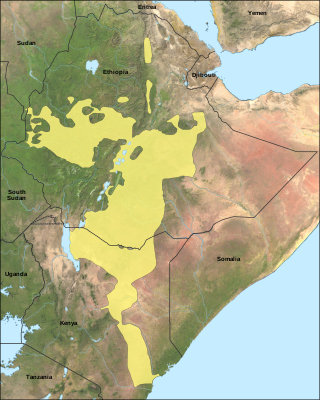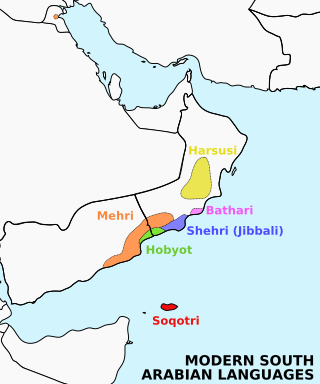Related Research Articles
In grammar, the locative case is a grammatical case which indicates a location. It corresponds vaguely to the English prepositions "in", "on", "at", and "by". The locative case belongs to the general local cases, together with the lative and separative case.

Oromo, historically also called Galla, is an Afroasiatic language that belongs to the Cushitic branch. It is native to the Ethiopian state of Oromia and Northern Kenya and is spoken predominantly by the Oromo people and neighboring ethnic groups in the Horn of Africa. It is used as a lingua franca particularly in the Oromia Region and northeastern Kenya.

Sandawe is a language spoken by about 60,000 Sandawe people in the Dodoma Region of Tanzania. Sandawe's use of click consonants, a rare feature shared with only two other languages of East Africa – Hadza and Dahalo, had been the basis of its classification as a member of the defunct Khoisan family of Southern Africa since Albert Drexel in the 1920s. Recent investigations however suggest that Sandawe may be related to the Khoe family regardless of the validity of Khoisan as a whole. A discussion of Sandawe's linguistic classification can be found in Sands (1998).

Shilha, now more commonly known as Tashelhiyt, Tachelhit, is a Berber language spoken in southwestern Morocco. When referring to the language, anthropologists and historians prefer the name Shilha, which is in the Oxford English Dictionary (OED). Linguists writing in English prefer Tashelhit. In French sources the language is called tachelhit, chelha or chleuh.

Neapolitan is a Romance language of the Italo-Romance group spoken in Naples and most of continental Southern Italy. It is named after the Kingdom of Naples, which once covered most of the area, since the city of Naples was its capital. On 14 October 2008, a law by the Region of Campania stated that Neapolitan was to be protected.
The Eastern Nilotic languages are one of the three primary branches of the Nilotic languages, themselves belonging to the Eastern Sudanic subfamily of Nilo-Saharan; they are believed to have begun to diverge about 3,000 years ago, and have spread southwards from an original home in Equatoria in South Sudan. They are spoken across a large area in East Africa, ranging from Equatoria to the highlands of Tanzania. Their speakers are mostly cattle herders living in semi-arid or arid plains.
The morphology of the Welsh language has many characteristics likely to be unfamiliar to speakers of English or continental European languages like French or German, but has much in common with the other modern Insular Celtic languages: Irish, Scottish Gaelic, Manx, Cornish, and Breton. Welsh is a moderately inflected language. Verbs inflect for person, number, tense, and mood, with affirmative, interrogative, and negative conjugations of some verbs. There is no case inflection in Modern Welsh.
Crasis is a type of contraction in which two vowels or diphthongs merge into one new vowel or diphthong, making one word out of two (univerbation). Crasis occurs in many languages, including Spanish, Portuguese, and French; it was first described in Ancient Greek.
This article describes the grammar of the Scottish Gaelic language.
Lango is an Eastern Nilotic language spoken by an estimated 38,000 people in South Sudan.
This article discusses the grammar of the Western Lombard (Insubric) language. The examples are in Milanese, written according to the Classical Milanese orthography.
Breton is a Brittonic Celtic language in the Indo-European family, and its grammar has many traits in common with these languages. Like most Indo-European languages it has grammatical gender, grammatical number, articles and inflections and, like the other Celtic languages, Breton has mutations. In addition to the singular–plural system, it also has a singulative–collective system, similar to Welsh. Unlike the other Brittonic languages, Breton has both a definite and indefinite article, whereas Welsh and Cornish lack an indefinite article and unlike the other extant Celtic languages, Breton has been influenced by French.

Shehri,, also known as Jibbali, is a Modern South Arabian language. It is spoken by a small native population inhabiting the coastal towns and the mountains and wilderness areas upland from Salalah, located in the Dhofar Governorate in southwestern Oman.

In linguistic morphology, inflection is a process of word formation in which a word is modified to express different grammatical categories such as tense, case, voice, aspect, person, number, gender, mood, animacy, and definiteness. The inflection of verbs is called conjugation, and one can refer to the inflection of nouns, adjectives, adverbs, pronouns, determiners, participles, prepositions and postpositions, numerals, articles, etc., as declension.
The Lopit people are an ethnic group found in Eastern Equatoria State, South Sudan. Traditionally, they refer to themselves as donge (plural) or dongioni (singular). The Lopit number 160,000 to 200,000 people living in the Lopit area, in the Lopit mountains which extend from the east to the north of Torit.
The morphology of the Welsh language shows many characteristics perhaps unfamiliar to speakers of English or continental European languages like French or German, but has much in common with the other modern Insular Celtic languages: Irish, Scottish Gaelic, Manx, Cornish, and Breton. Welsh is a moderately inflected language. Verbs conjugate for person, tense and mood with affirmative, interrogative and negative conjugations of some verbs. A majority of prepositions inflect for person and number. There are few case inflections in Literary Welsh, being confined to certain pronouns.
The Karamojong language is a Nilotic language spoken by the Karamojong people in Northeast Uganda.
Lokoya is an Eastern Nilotic language spoken by an estimated 85,000 people in South Sudan. It is also referred to by various other names, including Ellyria, Koyo, Loirya, Ohoromok, Lokoiya, Lokoja, Loquia, Lowoi, Oirya, Owoi, and Oxoriok.
Dongotono is an Eastern Nilotic language spoken by an estimated 5,000 people in South Sudan.
Cornish grammar is the grammar of the Cornish language, an insular Celtic language closely related to Breton and Welsh and, to a lesser extent, to Irish, Manx and Scottish Gaelic. It was the main medium of communication of the Cornish people for much of their history until the 17th century, when a language shift occurred in favour of English. A revival, however, started in 1904, with the publication of A Handbook of the Cornish Language, by Henry Jenner, and since then there has been a growing interest in the language.
References
- 1 2 3 4 Moodie, Jonathan (2020). A grammar of Lopit : an eastern Nilotic language of South Sudan. Leiden. ISBN 978-90-04-43067-9.
{{cite book}}: CS1 maint: location missing publisher (link) - 1 2 3 Lopit at Ethnologue (25th ed., 2022)

- ↑ Vossen, Rainier, The Eastern Nilote: Linguistic + Historic reconstructions, Berlin: Dietrich, Reimer Verlag 1982
- ↑ "Lopit Consonant & Vowel Book". SIL International. 2014-08-11. Retrieved 2019-01-25.
- ↑ "Lopit Grammar Book". SIL International. 2014-08-11. Retrieved 2019-01-25.
- Billington, Rosey (2017). The phonetics and phonology of the Lopit language (PhD thesis). University of Melbourne. hdl: 11343/192353 .
- Moodie, Jonathan Paul (2019). A grammar of the Lopit language (PhD thesis). University of Melbourne. hdl: 11343/227686 .